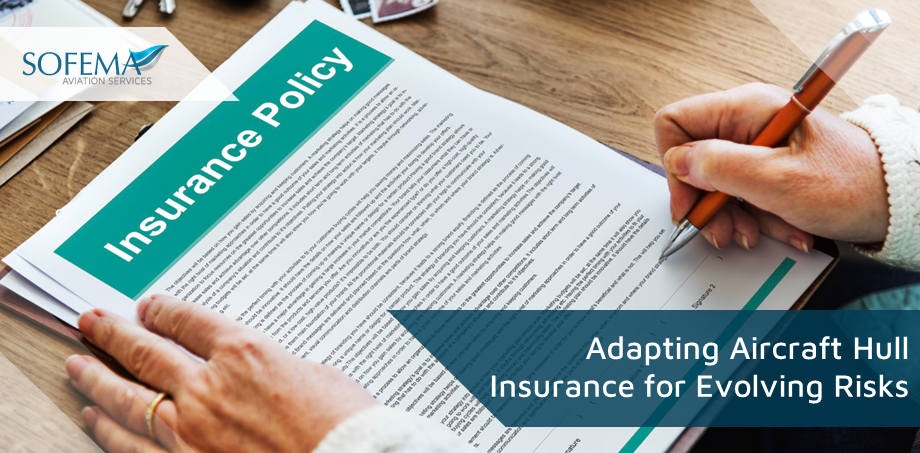Sofema Aviation Services (SAS) www.sassofia.com considers critical aspects of ensuring effective management of Aircraft Hull Insurance.
Introduction
Adjusting aviation aircraft hull insurance policies to address evolving risks is a complex but essential task. Together with regular policy reviews, collaboration with industry experts, leveraging technology, and continuous education, insurers can effectively manage these challenges and provide comprehensive coverage that meets the dynamic needs of the aviation industry.
Aviation aircraft hull insurance is designed to cover physical damage to the aircraft itself.
- As the aviation industry evolves, so do the associated risks, necessitating regular reviews and adjustments of insurance policies to ensure they remain adequate and relevant.
Here we discuss the challenges and best practices related to adjusting aviation aircraft hull insurance policies for evolving risks and the importance of regular policy reviews.
Challenges in Adjusting Policies for Evolving Risks
- Technological Advancements:
-
- Emerging Technologies: Introducing advanced avionics, composite materials, and unmanned aerial vehicles (UAVs) creates new risks.
- Insurers must understand these technologies to assess and price the risk accurately.
- Emerging Technologies: Introducing advanced avionics, composite materials, and unmanned aerial vehicles (UAVs) creates new risks.
-
- Cybersecurity Threats: Modern aircraft increasingly rely on digital systems, making them susceptible to cyber-attacks.
- These risks are difficult to quantify and require specialized knowledge to insure appropriately.
- Cybersecurity Threats: Modern aircraft increasingly rely on digital systems, making them susceptible to cyber-attacks.
- Regulatory Changes:
-
- International Regulations: The aviation industry is heavily regulated, with frequent safety and operational standards updates.
- Compliance with multiple jurisdictions can complicate insurance policy adjustments.
- International Regulations: The aviation industry is heavily regulated, with frequent safety and operational standards updates.
-
- Environmental Regulations: New environmental policies aimed at reducing emissions can impact the operational costs and risks associated with older aircraft, influencing insurance needs.
- Market Dynamics:
- Economic Fluctuations: Economic downturns can affect airline profitability, leading to changes in fleet sizes and operations, which must be reflected in insurance coverage.
-
- Global Events: Events like pandemics or geopolitical tensions can drastically alter air travel patterns and associated risks, requiring swift policy adjustments.
- Risk Assessment Complexity:
-
- Data Volume and Quality: The vast amount of data on modern aircraft must be accurately analyzed to assess risks. Poor data quality can lead to inadequate risk assessment.
-
- Dynamic Risk Landscape: The aviation risk landscape is continuously changing, requiring insurers to update their risk models and policies agilely.
Best Practices for Adjusting Policies
- Regular Policy Reviews:
-
- Scheduled Reviews: Conducting annual or bi-annual reviews of insurance policies ensures they stay relevant to the latest developments in aviation technology, regulations, and market conditions.
-
- Risk Assessments: Regular risk assessments should be integrated into the review process, utilizing the latest data and analytics to understand current risk exposures.
- Collaboration with Industry Experts:
-
- Technical Experts: Engage with aerospace engineers, cybersecurity specialists, and others to stay informed about technological advancements and emerging risks.
-
- Regulatory Bodies: Maintain close relationships with aviation regulatory bodies to stay ahead of regulatory changes and ensure compliance.
- Customized Coverage:
-
- Tailored Policies: Develop insurance policies tailored to the specific needs of different aircraft types and operations, considering factors such as aircraft age, technology, usage patterns, and geographic regions.
-
- Flexible Terms: Offer flexible policy terms that can be adjusted quickly in response to changes in risk profiles or operational needs.
- Leveraging Technology and Data Analytics:
-
- Big Data and AI: Use big data and artificial intelligence to enhance risk assessment and predictive modelling capabilities. This helps identify emerging risks early and adjust policies proactively.
- Enhanced Cybersecurity Measures:
-
- Cyber Risk Insurance: Develop comprehensive cyber risk insurance policies that cover potential cyber threats to aircraft systems.
-
- Cyber Resilience Programs: Encourage clients to implement robust cybersecurity measures and provide support for developing cyber resilience programs.
- Continuous Education and Training:
-
- Training Programs: Implement continuous education and training programs for underwriters and claims adjusters to keep them updated on the latest industry trends and risk factors.
-
- Workshops and Seminars: Organize workshops and seminars with industry stakeholders to discuss evolving risks and best practices in aviation insurance.
Importance of Regular Insurance Policy Reviews
Regular reviews of insurance policies are crucial for several reasons:
- Adaptation to Changes:
-
- Ensures that policies remain relevant and provide adequate coverage in light of technological advancements, regulatory changes, and evolving market conditions.
- Risk Management:
-
- It helps identify and mitigate emerging risks before they result in significant losses. Regular reviews allow for timely adjustments to coverage and terms.
- Client Trust and Satisfaction:
- Demonstrates a proactive approach to risk management and client care, fostering trust and long-term client relationships.
- Financial Stability:
-
- Maintains insurers’ financial stability by accurately pricing risks and adjusting policies to reflect the current risk environment.
Summary – Insurers can maintain effective and relevant policies by understanding and responding to technological advancements, regulatory changes, market dynamics, and the complexities of risk assessment.
- The identified best practices – including regular policy reviews, collaboration with industry experts, customized coverage, leveraging technology and data analytics, enhancing cybersecurity measures, and continuous education – provide a comprehensive framework for insurers to navigate the evolving risk landscape.
- Regular reviews are particularly vital, as they enable timely adaptations to changes, effective risk management, and enhanced client trust and satisfaction.
- By embracing these strategies, insurers can manage current challenges and anticipate future risks, ensuring robust coverage that supports the aviation sector’s long-term stability and growth.
Next Steps
Follow this link to our Library to find & download related documents for Free.
Sofema Aviation Services (www.sassofia.com) and Sofema Online (www.sofemaonline.com) provide Classroom, Webinar, and Online Training related to Aircraft Lease and Maintenance Reserves. Please see the websites or email Team@sassofia.com.
For the following course – Aircraft Leaseholder & Maintenance Reserve Insurance Considerations – Essentials – 1 Day
Tags:
Risk Management, SAS blogs, best practices, Aircraft Hull Insurance, Evolving Risks, Technological Advancements, Cybersecurity Threats, International Regulations, Environmental Regulations, Client Trust, Financial Stability





